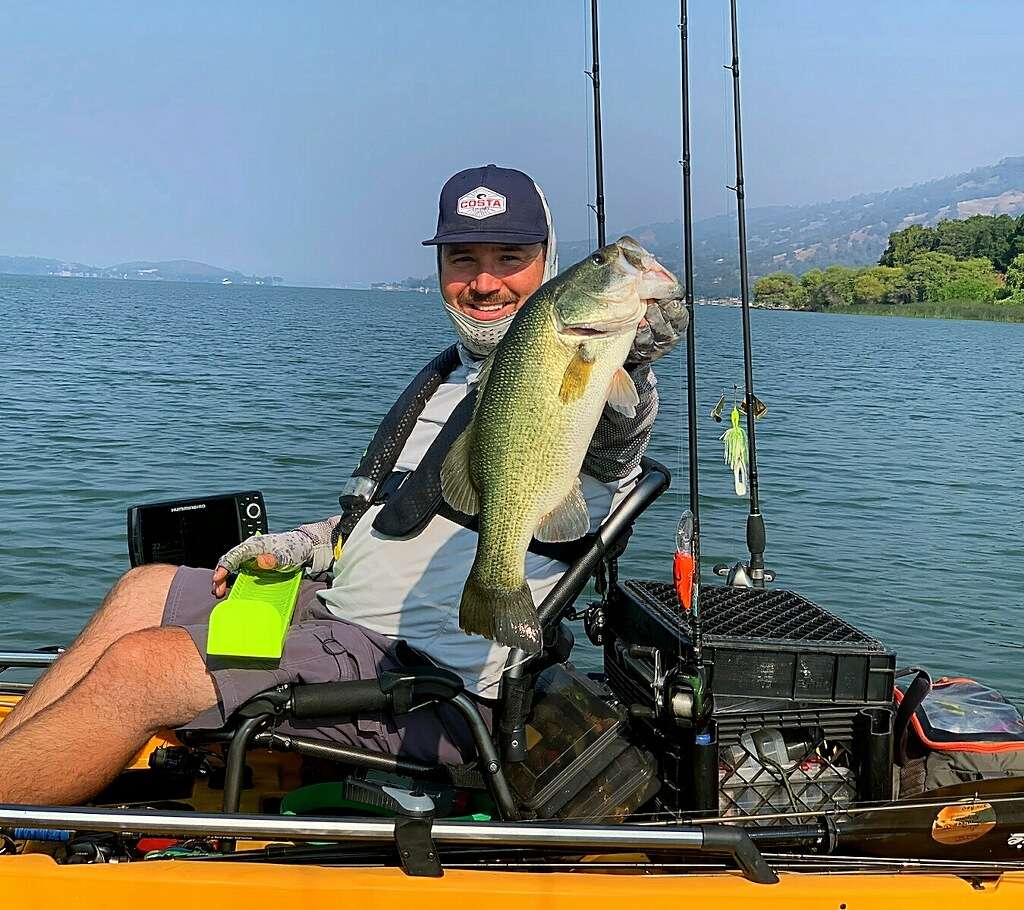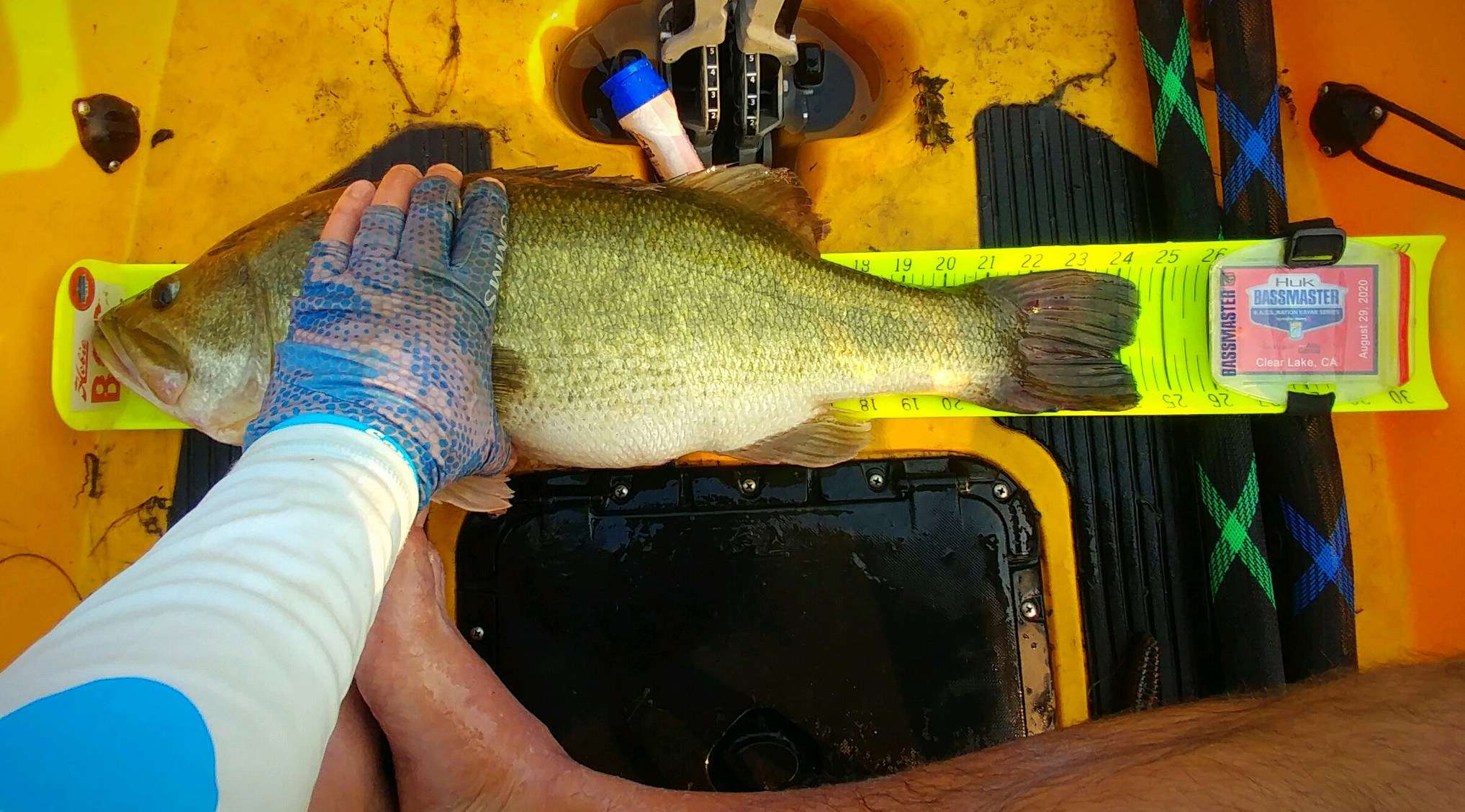
The horizon line was barely visible, blurred from the white sky and its reflection on the water. A hint of light broke over the hills, giving notice that “lines in” would soon commence. Anglers around the lake were either amidst launch, pedal, or float, amping up for competition.
Meanwhile, rod in hand, first-cast ready, Jason Borofka, of Salinas, Calif. was fighting newbie jitters on Clear Lake, the famed, big bass fishery that he once felt so familiar with.
“Just a few days before, I had never even been in a kayak and there I was sitting in one – one they called the big banana – because it was big and it was yellow – and, I was about to fish a tournament from it,” he recalled.
Borofka, a longtime pro competitor in the western bass fishing scene, was making the leap from bass boat to kayak.
This is the tale of how it played out and his takeaways from the experience.
Side note: Now that it is over, Borofka doesn’t put as much weight on the “bad luck banana” superstition held by many competing fishermen.
FLASHBACK: 48 HOURS AND COUNTING TO GAME DAY LAUNCH
Borofka arrived at Clear Lake, slid into a kayak for the first time, hit the Rattlesnake arm, and began practice for his first-ever kayak bass battle.
He launched last, watching and learning from the 10 or so guys that put in before him.
“Dude, where’s my trolling motor,” he said to his brother David, also practicing for competition, as he looked down at the big yellow kayak he borrowed for the event. “I didn’t realize there would be guys with actual trolling motors and I would be pedaling; but… there was.
“I dropped in, got a quick lesson in the rudder and fin, adjusted the pedal drive to my size and was on my way. Before I got too far away, I took a couple of trial runs at standing up. I wanted to do it near the shore, in case I fell out; but… I didn’t.”
The first practice fish Borofka landed from the kayak went 13-inches. It may have been close to a short, but it got the skunk off the big banana.
“I practiced positioning the fish on the measuring board, taking pictures and sending ‘em out for proof, he stated. “I wanted to get comfortable with doing that; because it’s not like you get another chance at it after you’ve released them back in the water.”

TOURNEYX TIME
Two days down and excited by his success in practice, Borofka splashed in for tournament blast off with a feeling he wasn’t used to.
“I was actually stiff and awkward,” he remembered. “I guess I would say I was nervous, which was so weird.
“In practice, I felt good. It was just like – yahoo, I’m fishing; but then, on tournament day, it was like I had never fished a tournament before. I kept thinking… oh, now what should I do.”
Launching near his target area, Borofka caught on rocket quick and was one of the first on the TourneyX board. That sparked a little confidence and instinct kicked in.
DOUBLE-DIDGE?
By hour three – 8:15 to 9:14 a.m., Borofka had snapped the biggest bass of the event on his board. It went 24.50 inches.
“I got it off of a four-foot, round clump of grass just under the surface, maybe a foot down,” he said. “I made two pitches – one in the middle and one on the side. I got no bites. The kayak drifted right next to the mat. I made one last pitch, right in the middle. My lure went all the way to the bottom – down deep – probably 10-feet. The fish hit it.
“I had my 8-foot rod fully bent over. I reeled three times and then, the fish knew it was hooked. I pulled and thought it was a catfish – until, I saw the white side and knew it was a bass. I put the net in the water to get it. The fish jumped and just as I got it in the net, the hook fell out.”
Borofka described his retrieve as a five-second fight that he won! Chalk it up to some good luck for the big banana.
“I was shocked by the size,” he added. “There were two boats on each side of me and the guys started yelling 15-pounder; but, I knew it wasn’t – possibly – probably, a 10. I looked down and couldn’t believe it was laying on my feet. I knew I had to get it on the board for photos; but it was so chubby and it was flopping.”
After a couple dozen pix – just to be sure, Borofka put her back in the net and let her go in the grass where she came from.
“It was so huge and there was no one around to celebrate with,” he said. “I scanned through my pictures. They didn’t do it justice. I found one to send, entered it and jumped right into the top-10 on TourneyX.”
ONE LAST KEY FISH
The clock was ticking and “lines out” was about to be called; but Borofka had one more cast to make. The cast would be critical to his first-ever kayak tournament.
With two minutes left, Borofka met up with his brother, “I was telling him what a good time I had and while I was talking. I saw a little patch of weeds,” shared Borofka. “I flipped my bait in. There was a boil as soon as it hit the water and I swung a 3 1/2-pounder in the kayak. As it came in, it went underneath the seat. My brother was yelling for me to take the picture. I got it and started snapping a million of them; but only one came out right. I submitted it!”
Borofka was told, the final pic made it in with 34 seconds to spare. It went 17.50 inches, culling out a 15.5 inches. The fish from the final cast boosted him from seventh to fourth.
Forty-eight hours of practice, one big banana, and a possible 10-pounder later, Jason Borofka went from his first time in a kayak to a fourth-place finish. A top-five plaque, a check, and a trip to the B.A.S.S. Nation Kayak Championship were his reward.
“It was so fun,” he said. “Even though it was a competitive tournament, the guys were so friendly. It is an entirely different atmosphere than a regular circuit.”
NINE TAKEAWAYS IN HIS OWN WORDS
Practice Positioning: Factor drift into your position for cast, retrieve, and hookset. I had to learn to pedal enough to drift; but not so much that I wouldn’t be able to stand up and cast at my target a couple of times before I passed it. Sometimes, I would drift, and be out of hookset position with my rod pointed toward my back. I’m still working on this.
Off-the-water study: Know when it takes what to win it. I know how to look up previous winning weights at tournaments that I usually fish; but with this, I wasn’t sure how lengths and weights went together. I looked at the number of inches it took to win other events at Clear Lake. I went into this knowing that I needed to have 90-inches or more to have a shot; but, I didn’t even know how long a four-pounder was. I practiced and figured out that a 13- to 17-inch fish is usually in that two- to three-pound range – at least Clear Lake fish were. I found there really wasn’t that much difference in those lengths; but after that, it seemed, every 1/4- to 1/2-inch, they got bigger and bigger.
An opportunity to be thorough: Pick it apart. In a bass boat, I cover water to be competitive. I can find fish and then get up and move to find more. In a kayak, if I pedal four miles one direction and find em, I’ve got to pedal four miles back; so, it was important to fish through a whole area and figure something else out that was working in the area that I already was. When I realized this, I started really slowing down, REALLY picking things apart. I took the time to find the right depth and the right speed that the fish wanted. I know this made the difference; because guys around me were fishing 1/2- and 3/4-ounce weights. I found they hit a 1 1/4-ounce weight much better. They wanted it flying.
Practice: It’s more than finding fish. I am confident in finding fish in practice. I am not confident in landing them in a kayak, putting them on a measuring board and taking pictures correctly. The fish flopped out of my hands so many times. I was lucky they didn’t go overboard. I want to practice building my technique AFTER catching them. I am still awkward and my mechanics aren’t on par with this … yet.
Gear: Keep it basic and simple. First of all, the less gear you have the less mess you will make, and keeping things orderly in the small space you have is very important. Keep your sitting and standing ability in mind when choosing which baits you tie on. Certain baits/techniques are easier to use when sitting than others.
Mechanics: Match your techniques to your kayak level of comfort and ability. I learned the limited physical space alters my casting and hookset mechanics; so, I have to be aware of that and choose baits that work with that. I also have to be aware of the rod storage behind the seat, so I don’t hit them during a cast – which I did. With certain techniques, I tend to move backward on a hookset. That is okay on a bass boat deck; but in a kayak, I can’t move backward or I fall. Yes, it happened and yes, I am learning how to adjust my mechanics to combat that.
Weigh-in without a scale: Getting a fish on a board for measurement and taking a photo for an entry is definitely something to practice. I want to be ready to secure a flopping 10-pounder on the measuring board with one hand, hold my phone and take a picture with the other, while at the same time thinking about all the details that make the picture correct.
Cellphones, chargers and backups: A cellphone becomes your proof of life in a kayak tournament. Now, I know a tether would make things a lot easier. I also learned the hard way a full charge and two backup battery power chargers are mandatory. Evidently, a phone continually roams around the lake, and a second backup power to your first backup is completely necessary to last an entire day.
Get ready to grow: I was so impressed with the kayak setups for traveling, trailers, trolling motors, and everything, I can see why kayak tournaments are growing so fast and with B.A.S.S. in the mix, it really draws attention. Kayaks allow anyone to live anywhere, on any budget, and fish a circuit at a competitive level trail. It is definitely something I am preparing to do again.
